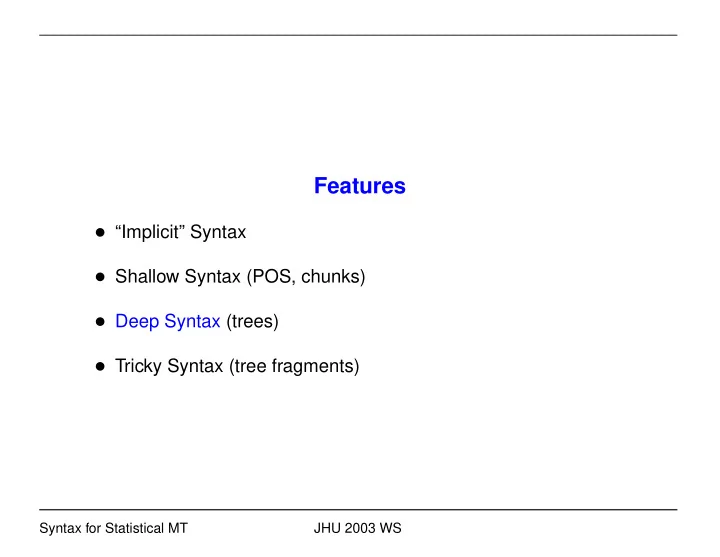

Features • “Implicit” Syntax • Shallow Syntax (POS, chunks) • Deep Syntax (trees) • Tricky Syntax (tree fragments) Syntax for Statistical MT JHU 2003 WS
Deep Syntax • What is deep? — use of parser output • Why parser? — grammaticality can be measured by parse trees • How to use parser output? – simple features – model-based features – dependency-based features – tree fragments Syntax for Statistical MT JHU 2003 WS
Simple features: Parser score Motivation: grammatical sentences should have higher parse prob. Feature Functions: • log ( parseProb ) (Alex) • log ( parseProb / trigramProb ) (Anoop) Result: worse than baseline Syntax for Statistical MT JHU 2003 WS
Does Parser give high probability for grammatical sentence? Parser LogProb for produced/oracle/reference sentences (Shankar) log ( parseProb ) produced -147.2 oracle -148.5 ref 1 -148.0 ref 2 -157.5 ref 3 -155.6 ref 4 -158.6 Syntax for Statistical MT JHU 2003 WS
Other simple parse-tree features Motivation: grammatical sentences should have specific tree shape. Feature Functions: (Anoop) • right branching factor • tree depth • num. of PPs • VP probs • ... Syntax for Statistical MT JHU 2003 WS
Model-based features Translation Model as Feature Function • Originally developed as a standalone model P ( f | e ) – Syntax-based model for parse trees • P ( f | e ) can be used as a feature value – Tree-based models represent systematic difference between two languages’ grammar ∗ e.g. SVO vs. verb-final word order ∗ constituents (e.g. NP) tend to move as a unit • Better translation should yield higher probs • featureVal = log [ P ( f | e )] Syntax for Statistical MT JHU 2003 WS
Syntax-based Translation Model Tree-based probability model for translation • Early work: – Inversion Transduction Grammar [Wu 1997] – Bilingual Head Automata [Alshawi, et. al 2000] • Tree-to-String [Yamada & Knight 2001] • Tree-to-Tree [Gildea 2003] Syntax for Statistical MT JHU 2003 WS
Syntax-based Translation Model (cont) Probabilistic operation on parse tree: • Reorder • Insert • Translate • Merge • Clone Parameters are estimated from training pairs (Tree/Tree, Tree/String) using EM algorithm. Syntax for Statistical MT JHU 2003 WS
Tree-to-String Alignment Yamada & Knight 2001 S NP 1 NP 2 NP 3 VB 4 Chu-Ka Kong-Keup-Mul 103 Tae-Tae Sa-Ryeong-Pu Cu S NP 3 VB 4 NP 2 NP 1 Sa-Ryeong-Pu Cu 103 Tae-Tae Chu-Ka Kong-Keup-Mul re-order step: P r ( 3 , 4 , 2 , 1 | S ⇒ NP NP NP VB ) Syntax for Statistical MT JHU 2003 WS
Tree-to-String Alignment 2 S NP VB NP NP the Sa-Ryeong-Pu Cu 103 Tae-Tae Chu-Ka Kong-Keup-Mul insertion step: P ins ( the ) P ( ins | NP ) S NP VB NP NP Headquarters gave the 103rd battalion additional supplies translation step: P t ( give | Cu ) Syntax for Statistical MT JHU 2003 WS
Tree-to-Tree Alignment Chinese tree: Merge/Split nodes: xianzhu xianzhu chengjiu chengshi chengjiu chengshi jianshe shisi Zhongguo shisi bianjing kaifang jingji jianshe Zhongguo bianjing kaifang jingji ge Zhongguo ge Lexical Translation: marked Reorder: xianzhu cities achievements chengjiu chengshi jianshe ’s 14 open border economic shisi kaifang bianjing Zhongguo jingji ge China Zhongguo Syntax for Statistical MT JHU 2003 WS
Cloning example S VP VP VP NP LV NP Ci-Keup VP NP NNC VV issued Myeoch Su-Kap Pat Ci NP LV NNX how gloves each you Ci-Keup Ssik Khyeol-Re VV NULL many pairs Pat Ci NULL NULL Syntax for Statistical MT JHU 2003 WS
Problems • n -best list doesn’t contain big word jump – reordering at upper node is useless • English/Chinese word-order is almost the same – both SVO in general – but relative clause comes before noun • Computationally expensive – use word-level alignment from MT output – limit by sentence length and fanout – break up long sentences into small fragments (machete) Syntax for Statistical MT JHU 2003 WS
Experiments Tree-to-String (Kenji, Anoop) • Trained on 3M words of parallel text – English side parsed by Collins • Max sentence length 20 Chinese characters – 273/993 sentences covered Tree-to-Tree (Dan, Katherine) • Trained on 40,000 biparsed FBIS sentences • Max fan-out 6, max sentence length 60 – 525/993 sentences covered Syntax for Statistical MT JHU 2003 WS
Results BLEU% Baseline 31.6 ParseProb 31.6 ParseProbDivLM 31.0 RightBranching 31.6 TreeDepth 31.5 numPPs 31.3 VPProb 31.3 Tree-to-String 31.7 Tree-to-Tree 31.6 Syntax for Statistical MT JHU 2003 WS
Lessons / Directions • Feature combination: BLEU 31.6 → 33.2 • But two thirds of improvement from lexical probs (IBM model 1) • Hard to use off-the-shelf taggers, parsers, etc • Limitations of rescoring n-best lists: syntax-based decoders • Probelms with evaluation metric: – human evaluation – syntax-based measures Syntax for Statistical MT JHU 2003 WS
Recommend
More recommend